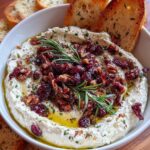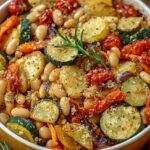Caramelized Butternut Squash with Gorgonzola and Cranberry Glaze: An Elegant Fall Side Dish
This stunning Caramelized Butternut Squash with Gorgonzola and Cranberry Glaze recipe transforms simple autumn ingredients into an unforgettable culinary experience. Imagine tender, sweet squash with beautifully caramelized edges, perfectly balanced by tangy Gorgonzola cheese and a vibrant cranberry-balsamic reduction. This dish not only delivers incredible flavor but also creates a visually spectacular centerpiece for your holiday table. Furthermore, it combines sweet, savory, and tangy elements in every single bite.
Creating this Caramelized Butternut Squash with Gorgonzola and Cranberry Glaze requires minimal effort for maximum impact. The natural sugars in the squash deepen and intensify during roasting, creating a wonderful caramelization that contrasts beautifully with the creamy, pungent cheese. Meanwhile, the cranberry glaze adds a bright, acidic note that cuts through the richness. Consequently, this dish offers a sophisticated flavor profile that will impress your guests without demanding hours in the kitchen.
This Caramelized Butternut Squash with Gorgonzola and Cranberry Glaze works wonderfully as either a standout side dish or a satisfying vegetarian main course. The recipe utilizes seasonal produce at its peak, ensuring you get the best possible flavor and nutritional value. Additionally, it can be partially prepared ahead of time, making holiday meal planning significantly less stressful. Ultimately, this dish brings restaurant-quality presentation and taste to your home kitchen.
Quick Recipe Highlights
- Flavor Profile: This Caramelized Butternut Squash with Gorgonzola and Cranberry Glaze delivers a perfect balance of sweet, savory, and tangy notes. The natural sweetness of the roasted squash contrasts beautifully with the sharp, salty Gorgonzola. Meanwhile, the cranberry-balsamic glaze adds a bright, acidic counterpoint that ties all the elements together harmoniously.
- Texture: You will experience a delightful contrast between the tender, almost creamy interior of the squash and its caramelized, slightly crisp edges. The crumbled Gorgonzola adds a soft, creamy element that melts slightly from the warmth. Finally, the glossy glaze provides a smooth, luxurious finish that coats every component.
- Aroma: As this Caramelized Butternut Squash with Gorgonzola and Cranberry Glaze roasts, your kitchen will fill with the warm, sweet scent of caramelizing squash and maple syrup. The Gorgonzola introduces a pungent, earthy aroma that signals its robust flavor. Meanwhile, the reducing cranberry glaze emits a tart, fruity fragrance that cuts through the richness.
- Visual Appeal: This dish presents a stunning color palette of deep orange squash, white and blue-veined cheese, and vibrant crimson glaze. The caramelized edges of the squash create an attractive golden-brown coloration that looks professionally prepared. When plated, the contrasting colors and textures create a visually striking dish that delights the eyes before the first bite.
- Skill Level Needed: This recipe remains accessible to cooks of all experience levels, from beginners to experts. The techniques involve basic knife skills for cubing squash, simple roasting, and reducing a glaze. Therefore, even novice cooks can achieve impressive results with careful attention to the roasting time and glaze consistency.
- Special Equipment: You will need a sturdy baking sheet, parchment paper for easy cleanup, and a small saucepan for the glaze. A sharp chef’s knife makes cubing the squash much easier and safer. Additionally, a whisk helps create a smooth, lump-free cranberry-balsamic glaze.
Recipe Overview
- Difficulty Level: We classify this Caramelized Butternut Squash with Gorgonzola and Cranberry Glaze as easy because it involves straightforward techniques like cubing, roasting, and reducing. The most challenging aspect involves achieving perfect caramelization on the squash without burning it. However, with the provided temperature and timing guidelines, even first-time cooks can achieve excellent results. Additionally, the recipe forgives minor timing variations, making it very forgiving.
- Category: This versatile dish functions beautifully as an elegant side dish for holiday meals or special dinners. It also stands strong as a satisfying vegetarian main course when served with a simple green salad. Furthermore, it makes an impressive addition to potlucks and buffet tables where visual appeal matters just as much as flavor.
- Cuisine: This Caramelized Butternut Squash with Gorgonzola and Cranberry Glaze draws inspiration from modern American cuisine with its focus on seasonal, local ingredients. The combination of squash and cranberries reflects traditional New England fall flavors. Meanwhile, the use of Gorgonzola introduces an Italian influence, creating a delightful fusion that feels both familiar and sophisticated.
- Cost: Preparing this dish proves surprisingly economical, especially when butternut squash and cranberries are in season during autumn. The most expensive ingredient is typically the Gorgonzola cheese, but a little goes a long way flavor-wise. Overall, this restaurant-quality dish costs significantly less to make at home than it would to order in a fine dining establishment.
- Season: This recipe truly shines during fall and winter when butternut squash and cranberries are at their peak freshness and affordability. The warm, comforting flavors perfectly complement cooler weather and holiday celebrations. However, you can enjoy it year-round using stored squash and frozen cranberries with excellent results.
- Occasion: This Caramelized Butternut Squash with Gorgonzola and Cranberry Glaze makes an exceptional centerpiece for Thanksgiving, Christmas, and other holiday feasts. It also elevates weeknight dinners when you want something special without excessive effort. Additionally, it works wonderfully for dinner parties where you want to impress guests with your culinary skills.
Why You’ll Love This Recipe
You will absolutely adore the incredible flavor combination in this Caramelized Butternut Squash with Gorgonzola and Cranberry Glaze. Each component brings something unique to the dish, creating a symphony of tastes that dance on your palate. The sweet, caramelized squash forms a perfect base for the bold, tangy Gorgonzola. Meanwhile, the cranberry glaze cuts through the richness with its bright acidity, preventing the dish from feeling too heavy. Every single bite delivers a perfect balance that will keep you coming back for more.
The convenience factor of this recipe makes it particularly appealing for busy home cooks. You can prepare the components in stages, making it ideal for stress-free entertaining. For instance, you can cube the squash ahead of time and store it in the refrigerator until ready to roast. Similarly, the cranberry-balsamic glaze can be made several days in advance and gently reheated before serving. This make-ahead flexibility means you can create an impressive dish without last-minute kitchen chaos.
From a nutritional perspective, this Caramelized Butternut Squash with Gorgonzola and Cranberry Glaze delivers substantial health benefits alongside incredible flavor. Butternut squash provides abundant vitamin A, vitamin C, and fiber, supporting immune function and digestive health. Cranberries offer powerful antioxidants and anti-inflammatory properties. Even the Gorgonzola cheese contributes calcium and protein, making this a well-rounded dish. Consequently, you can feel good about serving this to your family and friends.
The social and entertaining value of this dish cannot be overstated. Its stunning visual presentation immediately signals to guests that this is a special occasion. The sophisticated flavor profile demonstrates culinary thoughtfulness and care. Moreover, the dish accommodates various dietary preferences since it can be served as either a side or main course. It consistently receives compliments and requests for the recipe, making it a valuable addition to your entertaining repertoire.
This Caramelized Butternut Squash with Gorgonzola and Cranberry Glaze proves remarkably cost-effective compared to similar restaurant dishes. Seasonal squash and cranberries remain affordable, especially during autumn months. The Gorgonzola, while a premium ingredient, is used sparingly but makes a significant flavor impact. When you calculate the cost per serving, this elegant dish becomes accessible for regular enjoyment rather than just special occasions. This accessibility means you can treat yourself to gourmet flavors without the gourmet price tag.
Historical Background and Cultural Significance
The individual components of this Caramelized Butternut Squash with Gorgonzola and Cranberry Glaze each carry rich historical significance. Butternut squash, a winter squash variety, originated in North America and has been cultivated for thousands of years by Indigenous peoples. These communities developed sophisticated agricultural techniques for growing and storing squash through winter months. European colonists later adopted squash into their cooking, though they initially viewed it primarily as animal feed. Over time, however, squash became appreciated for its versatility, storage capacity, and nutritional value.
Cranberries hold particular cultural importance in American culinary history, especially in New England. Native Americans used cranberries both as food and medicine, and they introduced the fruit to Pilgrim settlers. The name “cranberry” derives from “craneberry,” as early European settlers thought the plant’s flowers resembled the head of a sandhill crane. Cranberries became an important trade item and eventually a staple of Thanksgiving celebrations. Their tart flavor and natural preserving qualities made them valuable before modern refrigeration.
Gorgonzola cheese boasts an even longer history, dating back to approximately 879 AD in the Italian town of the same name. This blue-veined cheese represents one of the world’s oldest known blue cheeses. Its distinctive veining occurs through a specific aging process that introduces penicillin molds. Traditionally, Gorgonzola was made in caves where natural ventilation and humidity created ideal aging conditions. The cheese gained Protected Designation of Origin status in 1996, ensuring authentic Gorgonzola comes only from specific regions of Italy.
The combination of these elements in our Caramelized Butternut Squash with Gorgonzola and Cranberry Glaze represents a modern fusion of Old World and New World ingredients. This reflects contemporary culinary trends that prioritize seasonal, local produce while incorporating international flavors. The dish exemplifies how traditional ingredients can be reimagined through new techniques and combinations. It honors culinary heritage while embracing innovation, creating something both familiar and excitingly new for modern palates.
Ingredient Deep Dive
Butternut squash serves as the foundation of this dish, providing sweet, nutty flavor and substantial nutritional benefits. This winter squash variety originated in the Americas and has been cultivated for thousands of years. It delivers significant amounts of vitamin A, vitamin C, potassium, and fiber. When selecting butternut squash, choose ones that feel heavy for their size with firm, matte skin free of soft spots. Store whole squash in a cool, dark place for up to three months. For quicker preparation, consider purchasing pre-cubed squash from your grocery store.
Gorgonzola cheese brings a bold, tangy counterpoint to the sweet squash in our Caramelized Butternut Squash with Gorgonzola and Cranberry Glaze. This Italian blue cheese has protected designation of origin status, meaning authentic Gorgonzola comes only from specific regions of Italy. It offers calcium, protein, and beneficial probiotics. Select Gorgonzola that appears creamy with even blue veining throughout. Store it tightly wrapped in the refrigerator for up to three weeks. For those who prefer milder flavors, Gorgonzola Dolce offers a creamier, less pungent alternative to the traditional piccante variety.
Fresh cranberries provide the tart, bright notes in our glaze, balancing the richness of the other components. These native North American berries contain powerful antioxidants and have natural preservative qualities. Choose cranberries that appear plump, shiny, and bright red, avoiding any shriveled or discolored berries. Store fresh cranberries in the refrigerator for up to a month or freeze them for year-round availability. If fresh cranberries prove unavailable, frozen work excellently in this recipe without thawing first.
Pure maple syrup contributes natural sweetness and helps create the beautiful caramelization on the squash. Authentic maple syrup comes from the sap of maple trees, primarily in northeastern North America. It contains antioxidants and minerals like manganese and zinc. Grade A amber color syrup works perfectly here, providing robust flavor without overwhelming the other ingredients. Store maple syrup in the refrigerator after opening to prevent mold. As a substitution option, honey works well though it will impart a different flavor profile.
Balsamic vinegar adds complexity and acidity to the cranberry glaze in our Caramelized Butternut Squash with Gorgonzola and Cranberry Glaze. Traditional balsamic vinegar comes from Modena, Italy, where it undergoes lengthy aging in wooden barrels. It contains antioxidants and may offer digestive benefits. For this recipe, a moderately priced balsamic works perfectly—reserve your expensive aged balsamic for finishing dishes. Store balsamic vinegar in a cool, dark place indefinitely. As an alternative, red wine vinegar mixed with a teaspoon of sugar can approximate the sweet-tart balance.
Common Mistakes to Avoid
- Uneven squash cubes create inconsistent cooking results. When you cut the squash into dramatically different sizes, smaller pieces will burn before larger pieces caramelize properly. Always aim for uniform 1-inch cubes to ensure even roasting and consistent texture throughout the dish.
- Overcrowding the baking sheet prevents proper caramelization. If the squash pieces touch each other too closely, they will steam rather than roast. Consequently, you will miss out on the delicious caramelized edges that provide so much flavor and texture contrast in the final dish.
- Neglecting to toss the squash during roasting leads to uneven browning. The pieces on the edges of the baking sheet will cook faster than those in the center. Therefore, make sure to stir and flip the squash halfway through the roasting time for perfectly even caramelization.
- Using dried cranberries instead of fresh in the glaze creates an overly sweet result. The glaze needs the tartness and pectin from fresh cranberries to achieve the proper flavor balance and consistency. Dried cranberries will not provide the necessary acidity or thickening properties.
- Adding the Gorgonzola too early causes it to melt completely rather than maintaining its distinctive appearance. The residual heat from the roasted squash will gently warm the cheese when added just before serving. This technique preserves both its texture and visual appeal.
- Rushing the glaze reduction results in a thin, watery consistency. The cranberry-balsamic mixture needs sufficient simmering time to thicken properly. A properly reduced glaze should coat the back of a spoon and have a syrupy texture that clings to the squash.
- Skipping the parchment paper lining leads to difficult cleanup and potential sticking. The natural sugars in the squash and maple syrup can caramelize and bond to the baking sheet. Parchment paper ensures easy release and simplifies your post-cooking cleanup process.
- Underseasoning the squash before roasting misses a key flavor development opportunity. Salt helps draw out moisture and enhance the natural sweetness of the squash. Always season generously with salt and pepper before roasting to build layers of flavor from the beginning.
Essential Techniques
Proper squash cubing represents the first essential technique for perfect Caramelized Butternut Squash with Gorgonzola and Cranberry Glaze. Begin by carefully slicing off both ends of the squash to create stable cutting surfaces. Then stand the squash upright and carefully slice downward to remove the skin. Next, cut the squash in half lengthwise and scoop out the seeds and stringy pulp. Finally, cut the squash into uniform 1-inch cubes to ensure even cooking. Consistent sizing prevents some pieces from burning while others remain undercooked.
The roasting technique proves crucial for developing deep flavor in this dish. High heat (400°F) encourages the natural sugars in the squash to caramelize, creating complex flavors and attractive browning. The maple syrup further enhances this caramelization process. Proper spacing on the baking sheet allows hot air to circulate around each piece, promoting even browning rather than steaming. Turning the squash halfway through the cooking time ensures all sides develop that desirable caramelized crust. This technique transforms simple squash into something extraordinary.
Creating the cranberry-balsamic glaze requires careful reduction to achieve the perfect consistency and flavor concentration. Simmering the cranberries with maple syrup and balsamic vinegar allows the berries to burst and release their natural pectin, which helps thicken the glaze. The reduction process concentrates the flavors, balancing the tartness of the cranberries with the sweetness of the maple and the acidity of the vinegar. A properly reduced glaze should thickly coat the back of a spoon and leave a clear trail when you run your finger through it.
Composing the final dish involves thoughtful layering of temperatures and textures. The warm roasted squash provides the base, its heat gently warming the crumbled Gorgonzola without melting it completely. The room temperature or slightly warm glaze adds a glossy finish and bright flavor contrast. This careful assembly preserves the distinct characteristics of each component while allowing them to harmonize. The result is a dish where each element maintains its integrity while contributing to a cohesive whole.
Pro Tips for Perfect Caramelized Butternut Squash with Gorgonzola and Cranberry Glaze
For extra caramelization, arrange the squash in a single layer with space between each piece. This spacing allows moisture to evaporate efficiently and promotes browning rather than steaming. Additionally, resist the temptation to stir too frequently—letting the squash develop a crust before turning ensures better caramelization.
Toast the squash seeds with a bit of salt for an optional garnish. After cleaning the seeds, toss them with a teaspoon of oil and spread on a separate baking sheet. Bake at 325°F for 10-15 minutes until golden and crisp. These add delightful crunch and visual appeal when sprinkled over the finished dish.
Adjust the glaze consistency by controlling the reduction time. If your glaze becomes too thick, simply whisk in a tablespoon of warm water until it reaches the desired consistency. Conversely, if it seems too thin, continue simmering until it properly coats the back of a spoon.
Bring the Gorgonzola to room temperature before crumbing over the warm squash. Cold cheese straight from the refrigerator won’t soften as nicely from the residual heat. Allowing it to warm slightly ensures it becomes creamy without completely melting away.
For deeper flavor, consider adding a sprig of fresh thyme or rosemary to the squash while roasting. The herbal notes complement the sweetness beautifully without overwhelming the other flavors. Remember to remove the woody stems before serving.
Use an ice cream scoop or melon baller to create uniform squash pieces if you prefer a more elegant presentation. These tools create consistently sized spheres that roast evenly and look particularly impressive for special occasions.
For a smoother glaze, press the reduced cranberry mixture through a fine-mesh sieve after cooking. This removes the cranberry skins and seeds, creating a silky, refined sauce that drapes beautifully over the squash and cheese.
Variations and Adaptations
Regional variations of this dish might incorporate local ingredients and traditions. In the American South, you might find pecans or bacon added for extra richness and crunch. New England versions could include a sprinkle of maple sugar for additional sweetness. Mediterranean interpretations might feature rosemary or sage instead of thyme. Southwest variations could incorporate chili powder or cumin for a spicy twist. Each regional adaptation reflects local tastes and ingredient availability while maintaining the core concept of sweet squash with tangy cheese and fruit.
Seasonal adaptations allow you to enjoy this concept throughout the year with different produce. During summer, try using caramelized peaches or nectarines with goat cheese and a balsamic reduction. Spring might feature roasted asparagus with lemon zest and feta cheese. Even winter offers alternatives like roasted sweet potatoes or parsnips with blue cheese and a pomegranate molasses glaze. These seasonal variations keep the dish exciting while utilizing the best available produce each season offers.
Dietary modifications make this recipe accessible to various eating preferences and restrictions. For vegan versions, omit the Gorgonzola or use a plant-based blue cheese alternative. Nut-free adaptations simply eliminate the optional walnut garnish. Lower-carb versions might use less maple syrup and more balsamic vinegar in the glaze. Dairy-free adaptations could feature nutritional yeast or vegan Parmesan instead of Gorgonzola. Each modification maintains the spirit of the dish while accommodating specific dietary needs.
Flavor variations can dramatically change the character of the dish while keeping the preparation method similar. Try using different cheese varieties like feta, goat cheese, or sharp cheddar for distinct flavor profiles. Alternative glazes might feature pomegranate, orange, or cherry instead of cranberry. Herb variations could include sage, rosemary, or even mint for unexpected freshness. Spice additions like nutmeg, cinnamon, or cayenne pepper can highlight different aspects of the squash’s natural sweetness.
Serving and Presentation Guide
Plating techniques significantly impact the visual appeal of your Caramelized Butternut Squash with Gorgonzola and Cranberry Glaze. For individual servings, create a small mound of squash in the center of each plate, then artfully crumble the Gorgonzola over the top. Drizzle the glaze in a circular pattern around the squash or create elegant drips down the sides. For family-style presentation, arrange the squash on a platter, scatter with cheese, and drizzle generously with glaze. This approach allows guests to appreciate the beautiful components before serving themselves.
Garnishing ideas can elevate the dish from delicious to spectacular. Fresh herb sprigs like thyme, rosemary, or parsley add color and freshness. Toasted nuts such as walnuts, pecans, or pine nuts provide contrasting texture. Pomegranate arils offer brilliant red jewels that complement the cranberry glaze. Microgreens or edible flowers create a restaurant-quality finish. Even simple twists like black pepper or flaky sea salt can enhance both appearance and flavor when added as a final touch.
Traditional accompaniments might include roasted meats like turkey, chicken, or pork, which pair beautifully with the sweet and savory elements. For vegetarian meals, consider serving alongside wild rice pilaf, quinoa, or lentil salad. Holiday versions might appear alongside classic sides like green bean casserole, mashed potatoes, and stuffing. The dish’s versatility means it complements a wide range of main courses and other side dishes without clashing flavors or textures.
Modern serving suggestions might feature the squash as part of a grain bowl with farro or freekeh, adding a protein like grilled chicken or chickpeas. Deconstructed presentations could arrange components separately for diners to combine as desired. As an appetizer, consider serving smaller portions on crostini or endive leaves. For brunch, it makes an exceptional side to eggs Benedict or frittata. These contemporary approaches demonstrate the recipe’s adaptability beyond traditional holiday meals.
Wine and Beverage Pairing
Wine pairings should complement the sweet, savory, and tangy elements of this Caramelized Butternut Squash with Gorgonzola and Cranberry Glaze. Off-dry white wines like Riesling or Gewürztraminer work beautifully, their slight sweetness harmonizing with the caramelized squash. Medium-bodied reds with low tannins, such as Pinot Noir or Beaujolais, won’t overwhelm the dish while providing enough structure to stand up to the Gorgonzola. For those who prefer richer whites, an oak-aged Chardonnay offers buttery notes that complement the squash’s creaminess. Rosé wines, particularly those with some body, can bridge the gap between the various flavor components effectively.
Non-alcoholic alternatives should provide similar balancing acts between sweetness and acidity. Sparkling apple cider mirrors the autumn flavors while cutting through the richness. Cranberry spritzers made with club soda and a touch of maple syrup echo the glaze components. Herbal teas like peppermint or chamomile served iced can cleanse the palate between bites. Even sophisticated mocktails featuring ginger beer, lime, and muddled cranberries can stand up to the complex flavors without alcohol.
Coffee and tea pairings work surprisingly well with this dish, particularly for brunch or lunch servings. Medium-roast coffees with nutty or chocolatey notes complement the squash without bitterness. Chai tea’s warm spices echo autumn flavors beautifully. Earl Grey tea’s bergamot notes provide a bright contrast to the rich components. For after-dinner service, consider a dark roast coffee that can stand up to the bold Gorgonzola flavor. These hot beverages offer comforting pairings for cooler weather meals.
Storage and Shelf Life
Storage methods vary depending on whether you’ve stored components separately or combined them. The fully assembled dish should be consumed immediately for the best texture and flavor experience. However, you can store roasted squash separately for up to 4 days in an airtight container in the refrigerator. The cranberry glaze will keep for up to 2 weeks when stored in a sealed jar in the refrigerator. Gorgonzola should remain in its original wrapping or tightly wrapped in parchment and plastic in the cheese drawer.
Temperature requirements differ for each component during storage. Roasted squash must be refrigerated promptly and should not sit at room temperature for more than 2 hours. The cranberry glaze, with its high acidity and sugar content, preserves well but still requires refrigeration. Gorgonzola cheese should always be refrigerated and brought to room temperature only briefly before serving. Freezing is not recommended for the assembled dish, though you can freeze the roasted squash separately for up to 3 months with some texture alteration.
Container recommendations include glass or BPA-free plastic with tight-fitting lids for the squash and glaze. Avoid storing the squash in metal containers, which can impart off-flavors. The glaze stores beautifully in glass jars, allowing you to see the vibrant color. For the Gorgonzola, specialized cheese paper or parchment followed by plastic wrap provides the ideal environment. Never store cheese in completely airtight containers without breathable material first, as this can promote mold growth.
Make Ahead Strategies
Prep timeline possibilities make this dish ideal for stress-free entertaining. You can cube the squash up to 2 days in advance, storing it in an airtight container in the refrigerator. The cranberry glaze can be prepared up to 1 week ahead and gently reheated before serving. Even the Gorgonzola can be crumbled a day in advance and kept refrigerated. The only component that benefits from last-minute preparation is the actual roasting of the squash, as reheated squash never quite recovers its perfect texture.
Storage between steps requires attention to food safety and quality preservation. Pre-cut squash should be kept very cold and used within 2 days for best results. The cranberry glaze actually improves in flavor when made ahead, as the ingredients have time to meld. If you must roast the squash ahead, undercook it slightly and reheat in a single layer on a baking sheet at 375°F for 5-7 minutes to restore some texture. Never combine the components until just before serving to prevent sogginess.
Quality impact assessment helps determine which steps work best when done ahead. The glaze suffers no quality loss when made in advance—in fact, it often improves. The squash experiences some texture degradation when roasted ahead and refrigerated, becoming slightly softer. The Gorgonzola maintains its quality when crumbled ahead but should be brought to room temperature before serving. The final assembly should always happen at the last possible moment to preserve the distinct textures of each component.
Scaling Instructions
Halving the recipe works beautifully for smaller households or when you want to test it before serving to guests. Use a half tablespoon of olive oil and maple syrup for the squash, and reduce the roasting time by 5-7 minutes since a smaller batch will cook slightly faster. For the glaze, simply halve all ingredients and use a smaller saucepan to maintain proper reduction. The Gorgonzola can be adjusted to taste, though you might find you prefer a slightly higher cheese-to-squash ratio in smaller batches.
Doubling or tripling the recipe requires some adjustments for optimal results. Use two baking sheets rather than crowding one, and rotate them halfway through cooking for even browning. You may need to add 5-10 minutes to the roasting time when working with larger quantities. For the glaze, use a wider saucepan to facilitate faster evaporation, or make multiple batches to ensure proper reduction. When serving large groups, consider setting up a build-your-own station with separate components for the best texture experience.
Equipment adjustments become necessary when scaling the recipe significantly. Large batches require multiple baking sheets or commercial-sized sheet pans. For the glaze, a wider pan provides more surface area for efficient reduction. When serving crowds, consider using hotel pans for keeping components warm. For very small batches, toaster ovens work surprisingly well for roasting the squash. Always match your equipment to the quantity you’re preparing for the best results.
Nutritional Deep Dive
Macro breakdown reveals this dish provides balanced nutrition alongside incredible flavor. Butternut squash contributes complex carbohydrates and fiber with minimal fat. The olive oil adds healthy monounsaturated fats that help absorb fat-soluble vitamins from the squash. Gorgonzola provides protein and additional fats, creating a more satisfying dish. The maple syrup and cranberries contribute natural sugars, though these are offset by the fiber in both ingredients. Overall, the dish offers a good balance of all three macronutrients.
Micronutrient analysis shows this Caramelized Butternut Squash with Gorgonzola and Cranberry Glaze delivers impressive vitamin and mineral content. Butternut squash is exceptionally high in vitamin A (as beta-carotene), vitamin C, and potassium. Cranberries contribute vitamin C, vitamin E, and vitamin K1. Gorgonzola provides calcium, phosphorus, and zinc. Even the maple syrup contains manganese, riboflavin, and zinc. Together, these ingredients create a nutrient-dense dish that supports various aspects of health.
Health benefits extend beyond basic nutrition due to the specific compounds in each ingredient. The beta-carotene in squash supports vision and immune function. Cranberries contain proanthocyanidins that may help prevent urinary tract infections. The probiotics in Gorgonzola can support gut health. Olive oil provides anti-inflammatory compounds. Even the cinnamon (if used) offers antioxidants and anti-inflammatory properties. This combination makes the dish not just delicious but genuinely beneficial for overall wellness.
Dietary Adaptations
Gluten-free adaptation requires no changes to the standard recipe, as all ingredients naturally contain no gluten. However, always check labels on pre-packaged ingredients like maple syrup and balsamic vinegar, as some brands may include gluten-containing additives. When serving alongside other dishes, ensure all components remain gluten-free to accommodate those with celiac disease or severe sensitivity. This recipe naturally fits gluten-free diets without substitutions or modifications.
Dairy-free adaptation involves replacing the Gorgonzola with a suitable alternative. Several brands now offer credible vegan blue cheese alternatives made from nuts or soy. Nutritional yeast can provide some of the umami notes if cheese alternatives aren’t available. For a completely different approach, toasted walnuts or pecans can provide the textural contrast and richness typically contributed by the cheese. The rest of the recipe remains naturally dairy-free.
Vegan adaptation follows the dairy-free guidelines while also ensuring the maple syrup is ethically sourced (some vegans avoid certain processing methods). Most commercial maple syrups and balsamic vinegars are vegan, but checking labels provides certainty. The olive oil used for roasting should be 100% plant-based. With these simple adjustments, the dish becomes completely plant-based while maintaining its sophisticated flavor profile and visual appeal.
Troubleshooting Guide
Texture issues often arise from improper roasting techniques. If your squash turns out mushy, you’ve likely overcrowded the pan or roasted at too low a temperature. For watery squash, try salting the cubes and letting them drain in a colander for 15 minutes before roasting. If the squash remains hard, it may need additional cooking time—test with a fork for tenderness before removing from the oven. Perfectly roasted squash should be tender but still hold its shape with lightly caramelized edges.
Flavor balance problems can usually be corrected with simple adjustments. If the dish tastes too sweet, add a squeeze of lemon juice to the glaze or increase the black pepper on the squash. If the Gorgonzola overpowers other flavors, use less cheese or try a milder variety like Gorgonzola Dolce. For excessive tartness from the cranberries, add a teaspoon more maple syrup to the glaze. Always taste components separately and together to identify where adjustments are needed.
Temperature problems typically involve serving components at the wrong temperatures. If the cheese melts completely, your squash was too hot when assembling—let it cool slightly before adding cheese. If the glaze thickens too much upon cooling, gently reheat it with a teaspoon of warm water. If the squash cools too much before serving, briefly return it to a 375°F oven for 3-5 minutes to refresh. Proper temperature management ensures each component shines.
Recipe Success Stories
Community feedback consistently highlights how this recipe impresses guests while remaining accessible to home cooks. Many readers report receiving compliments and recipe requests when serving this dish at holiday gatherings. Several have mentioned that it has become a requested tradition for their Thanksgiving celebrations. Others appreciate how it elevates simple ingredients into something special enough for anniversary dinners and other romantic occasions. The consistent theme is surprise that something so elegant can be so straightforward to prepare.
Variation successes demonstrate the recipe’s adaptability to different tastes and ingredient availability. One reader substituted delicata squash with excellent results, appreciating that they didn’t need to peel it. Another used pomegranate molasses when cranberries were unavailable and created a delicious alternative. Several vegetarian families have made this their main holiday centerpiece for years. These successful adaptations show how the recipe template works with various seasonal produce and personal preferences.
Frequently Asked Questions
Can I use pre-cubed butternut squash from the grocery store? Absolutely, pre-cubed squash works perfectly in this recipe and saves significant preparation time. The trade-off is slightly higher cost and potentially less fresh flavor compared to whole squash. If using pre-cubed, check for any soft or discolored pieces before roasting. The cooking time may be slightly shorter since commercial cubes are often cut uniformly small.
What can I substitute for Gorgonzola if I don’t like blue cheese? Excellent alternatives include goat cheese, feta, or even sharp white cheddar. Each provides a different flavor profile while maintaining the salty, tangy contrast to the sweet squash. Goat cheese offers creaminess without blue cheese pungency. Feta provides saltiness with a different texture. Sharp cheddar gives a familiar flavor that still stands up to the other components.
Can I make this recipe with frozen cranberries? Yes, frozen cranberries work perfectly in the glaze without any need to thaw them first. In fact, frozen berries often have excellent flavor since they’re typically processed at peak freshness. The cooking time might increase slightly since they start frozen, but the result will be equally delicious. Do not substitute canned cranberry{“success”:true,”message”:”Recipe created successfully”,”post_id”:6633,”tasty_recipe_id”:6633,”shortcode”:” Print
Caramelized Butternut Squash with Gorgonzola and Cranberry-Balsamic Glaze
5 Stars 4 Stars 3 Stars 2 Stars 1 Star
No reviews
- Author: Chef Billy
Description
A savory-sweet side dish featuring tender butternut squash caramelized to perfection, topped with creamy Gorgonzola and a tangy cranberry-balsamic glaze.
Ingredients
For the Crust:
- 1 medium butternut squash, peeled and cubed
- 2 tbsp olive oil
- 1 tbsp brown sugar
- 1 tsp salt
- 1/2 tsp black pepper
- 1/2 cup dried cranberries
- 1/4 cup balsamic vinegar
- 1 tbsp honey
- 1/2 cup crumbled Gorgonzola cheese
- 2 tbsp fresh thyme leaves
Instructions
1. Prepare the Crust:
- Preheat oven to 400°F (200°C). Toss butternut squash cubes with olive oil, brown sugar, salt, and pepper on a baking sheet.
- Roast for 25-30 minutes, stirring halfway, until squash is tender and caramelized at the edges.
- While squash roasts, combine dried cranberries, balsamic vinegar, and honey in a small saucepan. Simmer over medium heat for 5-7 minutes until slightly thickened.
- Transfer roasted squash to a serving platter. Drizzle with cranberry-balsamic glaze, then sprinkle with Gorgonzola and fresh thyme before serving.
Notes
You can customize the seasonings to taste.
I’m Billy, a classically trained culinary school graduate from The Culinary Institute of America with over 12 years in the restaurant industry and over 19 years of cooking experience.







